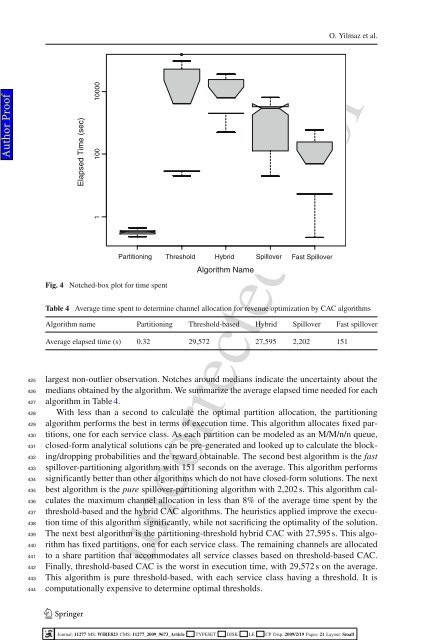Dear Author, Here are the proofs of your article. ⢠You can submit ...
Dear Author, Here are the proofs of your article. ⢠You can submit ...
Dear Author, Here are the proofs of your article. ⢠You can submit ...
- No tags were found...
Create successful ePaper yourself
Turn your PDF publications into a flip-book with our unique Google optimized e-Paper software.
O. Yilmaz et al.<strong>Author</strong> Pro<strong>of</strong>425426427428429430431432433434435436437438439440441442443444Elapsed Time (sec)1 100 10000Partitioning Threshold Hybrid Spillover Fast SpilloverAlgorithm NameFig. 4 Notched-box plot for time spentTable 4 Average time spent to determine channel allocation for revenue optimization by CAC algorithmsAlgorithm name Partitioning Threshold-based Hybrid Spillover Fast spilloverAverage elapsed time (s) 0.32 29,572 27,595 2,202 151largest non-outlier observation. Notches around medians indicate <strong>the</strong> uncertainty about <strong>the</strong>medians obtained by <strong>the</strong> algorithm. We summarize <strong>the</strong> average elapsed time needed for eachalgorithm in Table 4.With less than a second to calculate <strong>the</strong> optimal partition allocation, <strong>the</strong> partitioningalgorithm performs <strong>the</strong> best in terms <strong>of</strong> execution time. This algorithm allocates fixed partitions,one for each service class. As each partition <strong>can</strong> be modeled as an M/M/n/n queue,closed-form analytical solutions <strong>can</strong> be pre-generated and looked up to calculate <strong>the</strong> blocking/droppingprobabilities and <strong>the</strong> reward obtainable. The second best algorithm is <strong>the</strong> fastspillover-partitioning algorithm with 151 seconds on <strong>the</strong> average. This algorithm performssignifi<strong>can</strong>tly better than o<strong>the</strong>r algorithms which do not have closed-form solutions. The nextbest algorithm is <strong>the</strong> pure spillover-partitioning algorithm with 2,202 s. This algorithm calculates<strong>the</strong> maximum channel allocation in less than 8% <strong>of</strong> <strong>the</strong> average time spent by <strong>the</strong>threshold-based and <strong>the</strong> hybrid CAC algorithms. The heuristics applied improve <strong>the</strong> executiontime <strong>of</strong> this algorithm signifi<strong>can</strong>tly, while not sacrificing <strong>the</strong> optimality <strong>of</strong> <strong>the</strong> solution.The next best algorithm is <strong>the</strong> partitioning-threshold hybrid CAC with 27,595 s. This algorithmhas fixed partitions, one for each service class. The remaining channels <strong>are</strong> allocatedto a sh<strong>are</strong> partition that accommodates all service classes based on threshold-based CAC.Finally, threshold-based CAC is <strong>the</strong> worst in execution time, with 29,572 s on <strong>the</strong> average.This algorithm is pure threshold-based, with each service class having a threshold. It iscomputationally expensive to determine optimal thresholds.uncorrected pro<strong>of</strong>123Journal: 11277 MS: WIRE823 CMS: 11277_2009_9673_Article TYPESET DISK LE CP Disp.:2009/2/19 Pages: 21 Layout: Small
















